|
November 13, 2022
Dear Neighbors and Friends,
Happy Post-Election Day! I hope that you and your loved ones are doing well, staying healthy, and looking out for your neighbors and friends during this past week.
In tonight’s newsletter you’ll find some comments and perspective on the midterm elections, focusing on how it has gone and what it means for Oregon.
On the COVID front we see another week with mixed results and little change overall. Reported infections went up a little, while percent positivity, hospitalizations, ICU hospitalizations, and reported deaths went down from the previous week. This week’s report confirms last week’s OHSU forecast, which told us that the fall/winter wave would be more moderate and slower in coming than was originally expected.
For the sixth week in a row, all of Oregon’s counties remain at Low or Moderate risk. Wastewater analysis is showing only small changes from last week, with only one city showing an increase.
However, as the links to a number of sources tell us, we are seeing ongoing, increasing strain on our pediatric hospitals as a result of RSV, flu, along with COVID. You’ll find much more about that below, along with suggestions on how to deal with it.
Until next time, please do your best to stay healthy and safe. And let me know if you have any questions or thoughts about anything in this week’s newsletter.
State Election Debrief
As I write this on Sunday, we don’t yet know all the final results from the 2022 midterms, but we have a good sense of the likely outcomes of nearly every race. Not surprisingly, we didn’t know the outcome of the Governor’s race on election night, but by Wednesday morning—knowing where the outstanding ballots were—it was clear that Tina Kotek had managed to defeat both her rivals. Betsy Johnson, who ultimately secured less than 9% of the votes, made her concession speech on election eve.
Christine Drazan waited until Friday to concede, but it was a concession speech worth waiting for. She was gracious, positive, and forward-thinking in acknowledging Kotek’s victory. This came as a relief at this difficult time in our democracy. But I wasn’t surprised. Christine and I disagreed on many issues and tactics during the time we served together, but I always found her to be a very decent person and capable legislator. She’s the best candidate Republicans have nominated in many years. Yet even with the presence of a relatively strong third-party candidate, she was unable to prevail statewide.
On Tuesday night it already appeared likely that the Democrats would retain majorities in both the Senate and the House, and that was also confirmed by Wednesday morning. As I write this, Mark Meek from Clackamas County appears likely to have the votes to prevail in Senate District 20. Here's an article in the Oregon City News which explains why (with the delightful if misspelled title of “Meek Eeks Out a Victory for Oregon Senate Seat”).
Mark, who’s currently a state representative, will be our seventeenth Democrat in the Senate (out of 30 overall). From my perspective, this is great news, even if it amounts to a one-seat loss for Senate Ds this election overall, as we were previously at 18. Democrats technically had a supermajority of 18, but one of those 18 was Senator Betsy Johnson, who virtually always voted with Republicans on the controversial issues related to the environment and climate, worker rights, social justice, criminal justice reform, gun safety, tax reform, and consumer protection that were my priorities. As I joked during the election in predicting that we would land at 17, “Seventeen is the new eighteen!”
House Democrats appear to be giving up two seats, going from 37 to 35 out of 60, but it’s still a pretty comfortable majority. Looking forward, it will be a fascinating session to watch because 20 of the 60 House members will be new, and most of the remainder are still in their first term, many of them appointed within the last year. Relatively few House members have experienced a “normal” (i.e., pre-pandemic) session. Should be fascinating (and challenging).
In the end, despite all the ads and the dollars and the mailers and the criticism of the status quo, the partisan breakdown of the Legislature didn’t change much, and every Democratic incumbent in both chambers was reelected. In fact, the only incumbent to lose his seat was Bill Kennemer, the Republican whom Mark Meek appears to have defeated (and Bill, who has had a long legislative career, was appointed into this particular seat mid-term). That’s not to say that the Republicans didn’t run tough, aggressive campaigns. They did. I would say that in some cases they went too far in their attacks, particularly when they played the crime card and accused incumbents of stimulating crime by supporting a juvenile justice reform bill, while declining to mention that its primary sponsor was the late (Republican) Senator Jackie Winters.
But in the end, sadly, it was not surprising—for the Republicans this was their best chance for significant pickups in the Legislature (not to mention the Governor’s seat) since 2010 and likely for the next few years. But as we know, it wasn’t just in Oregon where the “Red Wave” failed to materialize. I’m really happy that this tactic didn’t work.
Also, I should mention that all four state ballot measures—those dealing with Affordable Healthcare (M111), Removing Slavery (M112), Ending Walkouts (M113), and Furthering Gun Safety (M114)—had clearly met the threshold to succeed by Wednesday morning. While the measure to reduce the likelihood of legislative walkouts passed overwhelmingly, Measures 111 and 113 were close, and passage of both was really a tribute to grassroots volunteerism.
So what’s up next? Now that we have a pretty clear sense of the makeup of the two caucuses in each chamber, it’s time for those caucuses to elect their leadership teams. This is particularly momentous for Senate Democrats because it means a change in the presidency of the Senate, the first such change since 2003. Senator Peter Courtney is leaving the Senate after many years of public service, and it’s time for new leadership in our chamber. Senate Democrats will be voting on our choices for new President, Majority Leader, and other officers next weekend at a caucus retreat. As you can imagine, it’s a contentious, exciting time (understatement). I’ll be writing my next newsletter while I’m there, so I’ll be giving you the latest news then. House Democrats will also be nominating their leaders this week.
Once we knew who our presiding officers will be, they’ll begin meeting with the Governor-elect and begin the work of transition. The Senate President and House Speaker will begin speaking with members of both parties to discuss committee assignments. The Governor-elect will begin crafting her budget proposal, which she’ll finalize and introduce early in the session.
The session itself begins with swearing-in on January 9 and the beginning of the actual session on January 17. It will be preceded by the final committee meetings and Senate floor session of the current Legislative Assembly during the week of December 5.
I promise to keep you up to speed as things progress. Please let me know if you have any questions about the process and how you can engage.
ON THE COVID FRONT
Weekly Data Report:
OHA now updates and reports COVID metrics once a week, on Wednesdays.
Here are the last set of daily results, for this past week from 11/3/22 through 11/9/22.
As you’ll see, this week’s report is a mix of slight increases, decreases, and in one case no change. It appears to affirm the observation that you’ll find in the new forecast from OHSU—that we are now experiencing a plateau that will soon transition to a brief wave in October and the first part of November.
- The 7-day average for new infections rose last week, from 360 last week to 401 reported infections per day. The number of new cases is again likely an undercount, as many people are using home tests to determine their infection status but are not reporting those results.
- Average test positivity for the last week went down slightly, to vs. the previous week’s 6.9%. Again, this number skews high because it likely reflects a higher proportion of people showing COVID symptoms (and thus going in for a test, rather than self-testing).
- On Wednesday there were 229 COVID-19-related hospitalizations statewide, dropping slightly from 230 last Wednesday. Hospitalizations are now our best indicator of disease spread. Again, however, most of these hospitalizations are not in and of themselves due to COVID—more than half are those who tested positive after having been admitted for other reasons.
- The number of COVID patients in Oregon’s ICUs on Wednesday was 28, going back down from last week’s 33. These are the most serious COVID infections.
- There were 17 COVID-19-related deaths reported during the last week, a big drop from the previous week’s 46. Again, some of every week’s reported deaths actually occurred in earlier weeks but were just reported to the state. The newsletter’s final graph shows when the deaths actually occurred, and you’ll see that the number of COVID deaths each day continues to remain low.
Weekly County Report: No High Risk Counties for the Sixth Week in a Row
The CDC assigns risk levels based on a combination of the number of new COVID cases and the number of people in hospital for COVID.
According to the CDC Daily Counter (updated each Thursday), none of Oregon’s 36 counties is currently at High Risk. All are either at Low Risk or Medium Risk.
Five Oregon counties (down from six) have reported infection rates that place them in the Medium Risk category: Baker, Curry, Josephine, Union, Wallowa,
The remaining 31 Oregon counties (up from 30 last week) are at Low Risk: Benton, Clackamas, Clatsop, Columbia, Coos, Crook, Deschutes, Douglas, Gilliam, Grant, Harney, Hood River, Jackson, Jefferson, Josephine, Klamath, Lake, Lane, Lincoln, Linn, Malheur, Marion, Morrow, Multnomah, Polk, Sherman, Tillamook, Umatilla, Wasco, Washington, Wheeler, and Yamhill.
We can also track the cases, deaths, and test positivity rates for each county at this website.
The three Portland-area counties all showed a decline in positivity rates from the previous week. Clackamas County is 6.9%, back down from last week’s 9.2%. Multnomah County is 6.1%, down from last week’s 6.8%. Washington County is also at 6.1%, down from last week’s 6.1%.
Remember that these are all based on reported test results, and so are more likely to be a little higher than the total percent positivity (i.e., if one were to include all tests taken).
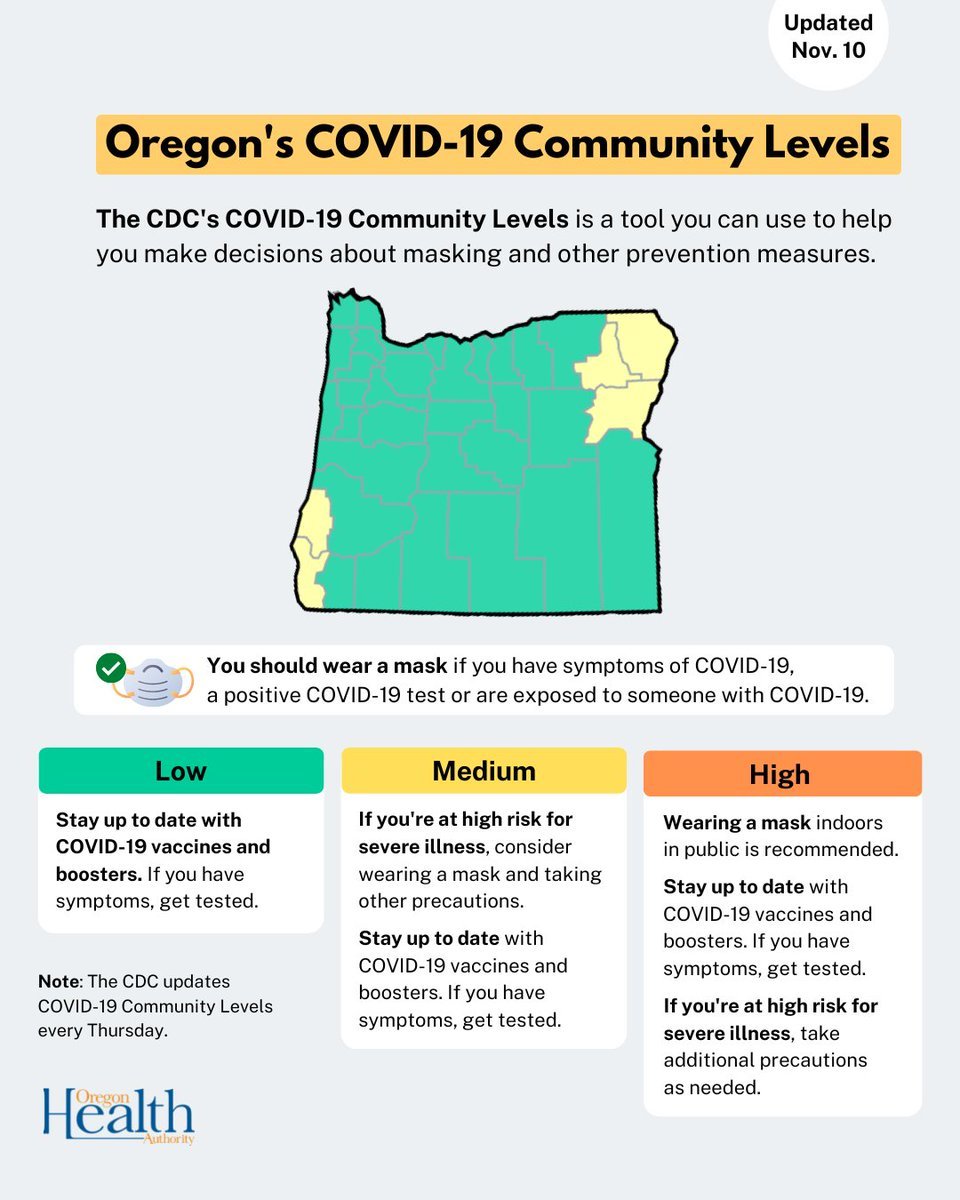
This Week’s Wastewater Monitoring Report: Again, Little Change from Last Week
With testing reports giving us just a fraction of infections out there, wastewater monitoring has become a more reliable indicator of the amount of virus in cities around the state. That report is updated each week.
This week’s report shows little change overall from last week. 86% of the cities tested showed no change. Eleven percent showed decreased viral load from the previous week. Three percent of the cities showed increases.
COVID Q & A from OHA’s Dr. Cieslak (from OHA weekly newsletter)
Dr. Paul Cieslak, OHA senior health advisor and medical director, Communicable Diseases and Immunizations, answered this week’s questions.
Q: I tested positive for COVID-19 Oct. 3rd, one day after symptoms began. I am still experiencing lingering symptoms, intermittent achy throat, head congestion and cough. I do not consider myself contagious but cannot find the data to support that assumption. Can you please help me clarify? It makes a difference to close family members. Thank you. – Jan, Deadwood
A: It’s impossible to say with 100% certainty, but it’s highly unlikely that you’re still contagious. Early studies showed that by day 14 after illness onset, live virus was still present in less than 1% of cases. Some patients have lingering symptoms from the initial infection; and other viruses are circulating, so it’s also possible that you have a different infection now.
Q: My son contracted COVID toward the end of June. Unfortunately, he now has long COVID. He had both of his shots and at least one of his boosters. When can he get the new bivalent booster? – Martha, Portland
A: I’m sorry your son is experiencing long COVID-19. Fortunately, however, it doesn’t have any impact on vaccine guidance. If he’s at least 5 years old, he can get the bivalent booster if it’s been two months since receiving his most recent COVID-19 (monovalent) booster.
Q: I am 76 and my husband is 85, both in good health. We tested positive for COVID-19 on Sept 28. We took Paxlovid. It took three weeks to the day before we tested negative. We are scheduled for air travel at Christmas to visit friends and will gather with their family that includes a college student who will travel cross country to join us. We've had all boosters except the bivalent (which we were scheduled for the day after our COVID-19 diagnosis). Everything I read advises waiting three months or longer for the new booster. That would put us right in the middle of our Christmas trip. I was thinking of getting it two weeks before we leave to give us maximum protection. What timing would you advise for our booster and why? – Sherwin, Portland
A: I would do exactly what you’re suggesting – get the bivalent booster two weeks before you travel. Immunity from your recent infection is likely to protect you until then, and the immunity from the booster should be high as you travel!
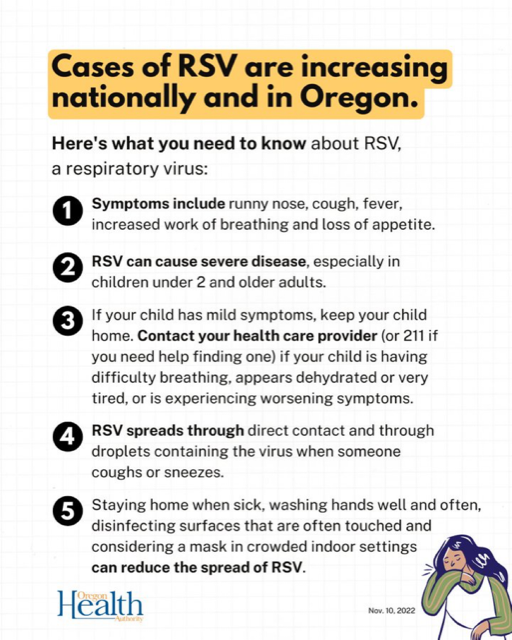
Additional COVID Updates and Links
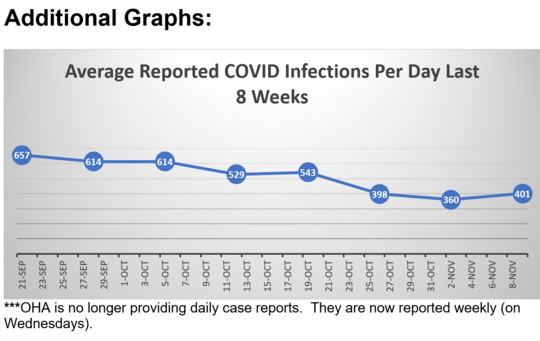




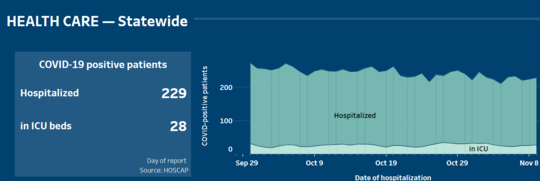
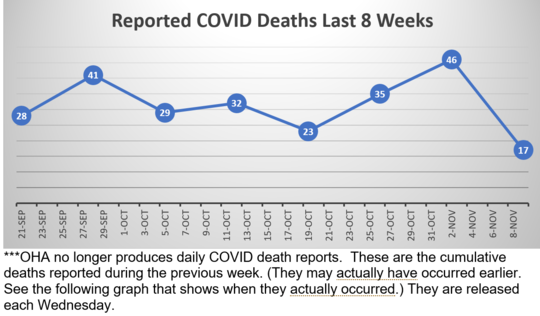

Here again are some COVID resources that you will find useful:
If the above links are not providing you with answers to your questions or directing you to the help that you need, please consider me and my office to be a resource. We’ll do our best to assist you or steer you in the right direction.
Want to See Past Newsletters?
If there was COVID-related information in a past newsletter that you want to go back to, but find you’ve deleted it, you can always go to my legislative website (senatordembrow.com), click on “News and Information,” and you’ll find them all there. Also, if someone forwarded you this newsletter and you’d like to get it directly, you can sign up for it there.
Best,
 Senator Michael Dembrow
District 23
email: Sen.MichaelDembrow@oregonlegislature.gov
web: www.senatordembrow.com
mail: 900 Court St NE, S-407, Salem, OR, 97301
|